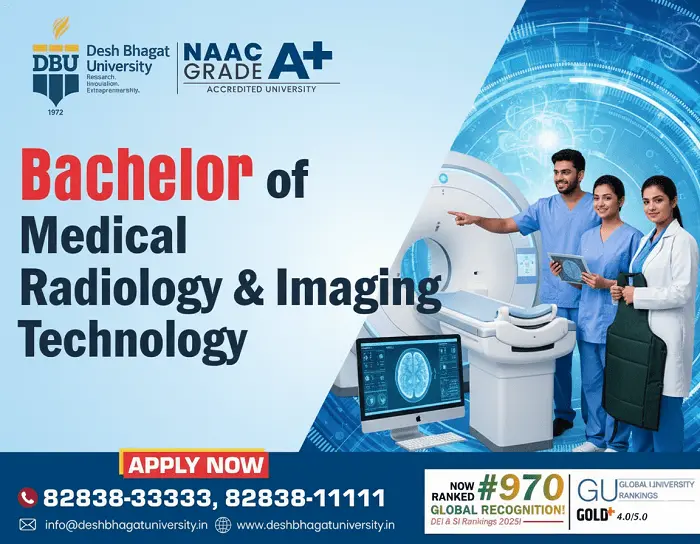BMRIT Course: Full Form, Syllabus, Duration, Fee and Eligibility
November 15, 2025 2025-11-15 9:01BMRIT Course: Full Form, Syllabus, Duration, Fee and Eligibility

BMRIT Course: Full Form, Syllabus, Duration, Fee and Eligibility
At Desh Bhagat University (DBU), we are proud to present our undergraduate programme, **Bachelor of Medical Radiology & Imaging Technology (BMRIT). This article gives you full details about the BMRIT full form, syllabus, duration, eligibility, scope, and expected salary. We have kept the information simple and clear so you can understand exactly what this programme offers and how it can benefit your career.
What is BMRIT (BMRIT Full Form)
At DBU, BMRIT stands for Bachelor of Medical Radiology & Imaging Technology. This is a specialised undergraduate degree designed to train you in the field of medical imaging and radiology technology. You learn how to use diagnostic imaging equipment, understand anatomy, physiology, radiation safety, and assist in the process of diagnosing and imaging diseases.
BMRIT Course – Why Choose It
The BMRIT course at DBU has been structured keeping in mind the needs of modern healthcare services. If you want to make a meaningful career working in diagnostic imaging, hospitals, medical centres, clinics, or even research, then this BMRIT course offers you a strong foundation. With imaging techniques growing rapidly (CT, MRI, ultrasound, X‑ray, etc.), professionals trained in radiology technology are in demand.
BMRIT Course Details
Here are the important BMRIT course details at DBU:
- The programme is offered in our Allied Health Sciences UG portfolio.
- The BMRIT course is designed for full‑time study, combining theory, practical sessions, and internship exposure.
- Duration: For direct entry (after 10+2 PCB), the duration is 3 + 1 year internship (i.e., 7th & 8th semesters include internship) / 8 semesters. For lateral entry, the duration is 2 + 1 year internship / 6 semesters.
- Eligibility for direct entry: 10+2 (Medical stream: Physics, Chemistry, Biology) with a minimum 50% aggregate (45% for reserved categories) or equivalent from a recognized board.
- Eligibility for lateral entry: A recognised Diploma in Radiology & Imaging Technology (DRIT) of 3 years after 10th OR DRIT of 2 years after 10+2, with at least 50% (45% for reserved).
- Note: Preference is given to candidates who are NEET qualified.
- Syllabus: While the full detailed syllabus covers many topics, some of the typical subjects you will study include medical terminology & record keeping, basic computers & information science, anatomy & physiology, physics of newer imaging modalities, clinical radiography, newer imaging techniques, quality control & radiation safety, hospital practice & patient care.
You will learn how diagnostic imaging works, how to use radiography, CT, MRI, ultrasound, patient care & safety, research methods, and hospital practicum.
- Fee: DBU does not publish a fixed fee for every programme publicly; you will need to contact our admissions office for the latest fee structure, scholarships, and instalment plans. (As indicated for similar programmes)
- Scope & Career: Upon successful completion of BMRIT, you will be prepared for roles such as radiology technologist, imaging technician, CT/MRI operator, ultrasound technologist, diagnostic imaging assistant, quality control technician in radiology departments, research assistant in imaging labs, etc.
- Salary (expected): Salaries vary by region, hospital type (private vs government), experience, and role. For illustration, paramedical imaging professionals in India may expect starting salaries in the range of ₹3‑6 lakhs per annum, rising with experience and specialisation.
BMRIT Syllabus – What you’ll learn
The BMRIT syllabus at DBU is designed to give you comprehensive knowledge plus hands‑on experience in imaging technology. The syllabus may change each semester, but the main topics include:
- Introduction to health delivery system in India, medical terminology, professionalism & values, basic computers & information science
- Anatomy & physiology, physics of imaging, radiographic techniques, imaging modalities (X‑ray, CT, MRI, and ultrasound), and patient care.
- Clinical practice and internship: You will participate in hospital practice, operate imaging machines under supervision, and understand radiation safety guidelines, quality assurance, and newer imaging modalities.
- Research methodology & biostatistics, medical law & ethics, communication & soft‑skills for working in a healthcare team.
- Directed clinical education: This ensures you are ready to step into professional work by the end of your internship.
BMRIT Course Duration
As already stated, the BMRIT course duration at DBU is:
- For Direct Entry: 3 years academic + 1 year internship = total 4 years (8 semesters)
- For Lateral Entry: 2 years academic + 1 year internship = total 3 years (6 semesters)
The internship year gives you real‑world hospital exposure, which greatly enhances your employability.
BMRIT Eligibility
To summarise eligibility again clearly:
Direct Entry
- Passed 10+2 with Physics, Chemistry, Biology (Medical stream) from a recognised board
- Minimum aggregate 50% (45% for reserved categories)
- Equivalent qualification acceptable
- Preference to NEET-qualified candidates
Lateral Entry
- A recognised Diploma in Radiology & Imaging Technology (DRIT) of 3 years after 10th OR DRIT of 2 years after 10+2
- Minimum 50% aggregate (45% for reserved categories)
- Equivalent qualification acceptable
- Preference to NEET-qualified candidates
Applicants who meet the eligibility requirements will further have to satisfy the University admission process (application, counselling, and fee submission) and may need to produce relevant documents.
BMRIT Course Fee
The fee for the BMRIT programme at Desh Bhagat University depends on various factors, such as the batch, campus, available resources, and equipment usage. Scholarships or fee concessions may also influence the final fee structure.
To get the most accurate and up-to-date information regarding the course fee, instalment plans, and available scholarships, we recommend that prospective students contact the DBU Admissions Office directly.
BMRIT Salary & Scope
Scope
Completing BMRIT opens up a variety of career options in the healthcare & diagnostic imaging sector:
- Radiology and imaging departments in hospitals, diagnostic centres
- CT/MRI/Ultrasound/CT‑Angio/Interventional imaging centres
- Quality control & radiation safety units
- Research units in imaging technology
- Teaching and training roles (after further study)
The growing healthcare industry and rising use of advanced imaging techniques mean that demand for trained professionals is increasing.
Salary
- As a fresh entrant with a BMRIT qualification, you can expect a salary in the range of approximately ₹3‑5 lakhs per annum in many places. (This is a broad guide; actual salary depends on role, location, hospital, and your practical skills.) DBU’s data for paramedical fields show similar starting ranges.
- With 2‑3 years of experience and specialised skills (e.g., MRI, CT, PACS, quality assurance), the salary can go higher, and you may move into senior technologist roles, supervisory or managerial roles in imaging.
- Scope for further studies: You can pursue postgraduate studies (M.Sc, M.Tech in radiology/imaging) or certifications, which further enhance salary & scope.
Why Choose BMRIT at DBU
Here’s why choosing BMRIT at DBU makes sense:
- DBU offers a dedicated Allied Health Sciences programme, including BMRIT, with a structured curriculum and an internship built in.
- The University focuses on combining theoretical knowledge with practical, clinical exposure, which is essential in the field of imaging technology.
- DBU ensures you meet recognised eligibility, and the programme prepares you for real‑world roles in healthcare imaging.
- The internship component helps you gain hands‑on experience, which adds to your employability and confidence.
- By choosing this programme, you align with a growing sector in healthcare services—imaging technology is vital across diagnosis, treatment, and research.

Summary
If you are interested in diagnostic imaging, love the idea of using cutting‑edge equipment like CT, MRI, ultrasound, X‑ray, and you want to work in healthcare but prefer a technical/technology‑oriented role rather than purely clinical, then the BMRIT (Bachelor of Medical Radiology & Imaging Technology) at Desh Bhagat University is a great option. You’ll turn your interest into real skills and a career path.
FAQs
1. What is BMRIT?
BMRIT is an undergraduate course that teaches students how to use medical imaging techniques like X-ray, MRI, CT scans, and ultrasound. Students will learn how to operate the equipment, understand medical anatomy, and ensure patient safety while performing diagnostic imaging.
2. What is the full form of BMRIT?
The full form of BMRIT is Bachelor of Medical Radiology & Imaging Technology. This course focuses on training students to become experts in medical imaging and radiology technology, which are essential for diagnosing diseases and conditions through advanced imaging techniques used in healthcare settings.
3. What is the duration of the BMRIT course at Desh Bhagat University?
The BMRIT course at Desh Bhagat University takes 3 years for direct entry students, followed by a 1-year internship (total of 4 years). For lateral entry students who already have a relevant diploma, the duration is 2 years of study and 1 year of internship, totaling 3 years.
4. What are the eligibility requirements for BMRIT?
To be eligible for the BMRIT course at Desh Bhagat University, you need to have passed 10+2 with Physics, Chemistry, and Biology (Medical stream) from a recognized board, with at least 50% marks (45% for reserved categories). For lateral entry, a Diploma in Radiology or Imaging Technology is required.
5. What is the syllabus for the BMRIT course?
The BMRIT syllabus covers subjects such as Medical Terminology, Anatomy & Physiology, Radiography Techniques, CT & MRI Imaging, Patient Care, and Radiation Safety. It also includes practical sessions, research methods, and an internship to provide hands-on experience in real-world medical imaging environments.
6. What is the fee for the BMRIT course at Desh Bhagat University?
The exact fee for the BMRIT course at Desh Bhagat University is based on the batch, campus, and resources used. For detailed information, it is recommended to contact the admissions office directly. The university also offers various scholarships and installment plans to make education more accessible.
7. What is the career scope after completing BMRIT?
After completing the BMRIT course, graduates can work in various healthcare settings such as hospitals, diagnostic centres, and research labs. Roles include Radiology Technologist, Imaging Technician, MRI/CT Operator, Quality Control Technician, and more. The demand for trained imaging professionals is high, ensuring excellent career opportunities.
8. What salary can I expect after completing BMRIT?
The starting salary for BMRIT graduates ranges between ₹3 to ₹5 lakhs per annum. This can increase with experience, skill specialization (e.g., in MRI or CT), and seniority. Highly skilled professionals in imaging technology can earn more, especially with experience in private hospitals or research roles.
9. Can I pursue higher studies after completing BMRIT?
Yes, after completing BMRIT, you can pursue higher studies like a Master’s in Radiology, M.Sc. in Medical Imaging, or even Ph.D. in Imaging Technology. You can also take up advanced certifications to specialize in specific imaging technologies like MRI, CT, or Ultrasound.
10. How is the internship structured in the BMRIT course?
The internship is an important part of the BMRIT course at Desh Bhagat University. It is done in the final year and lasts for one year (two semesters). During the internship, students gain hands-on experience in hospitals and diagnostic centers, working directly with imaging equipment and learning to perform diagnostic tests under supervision.






